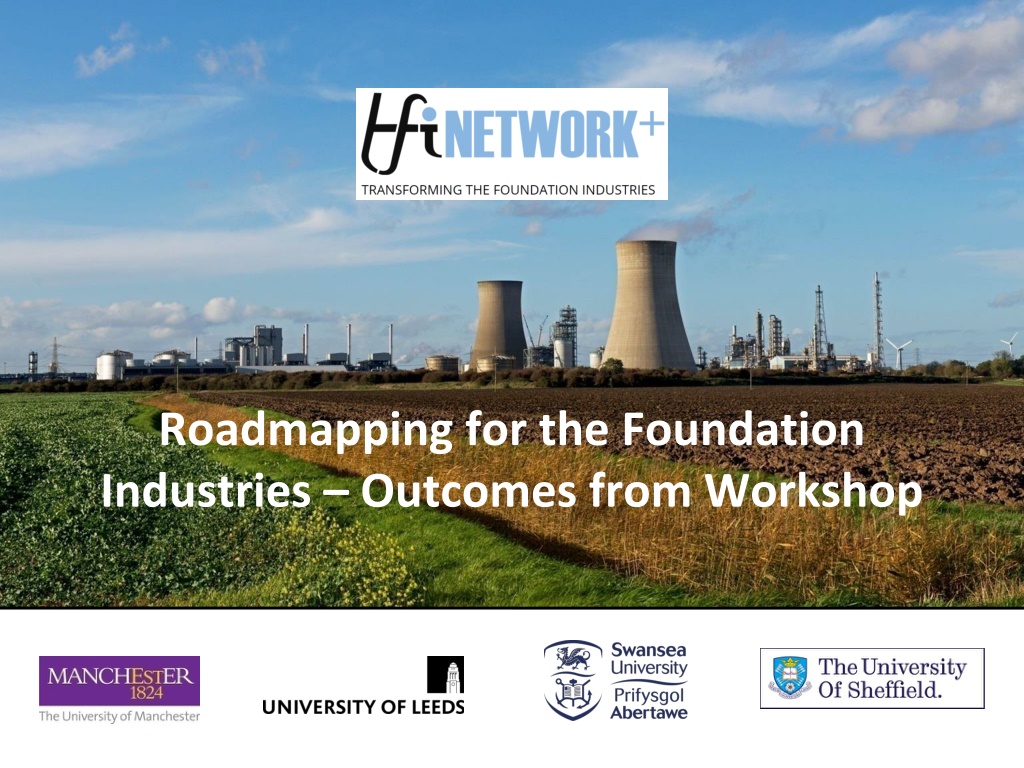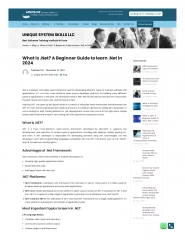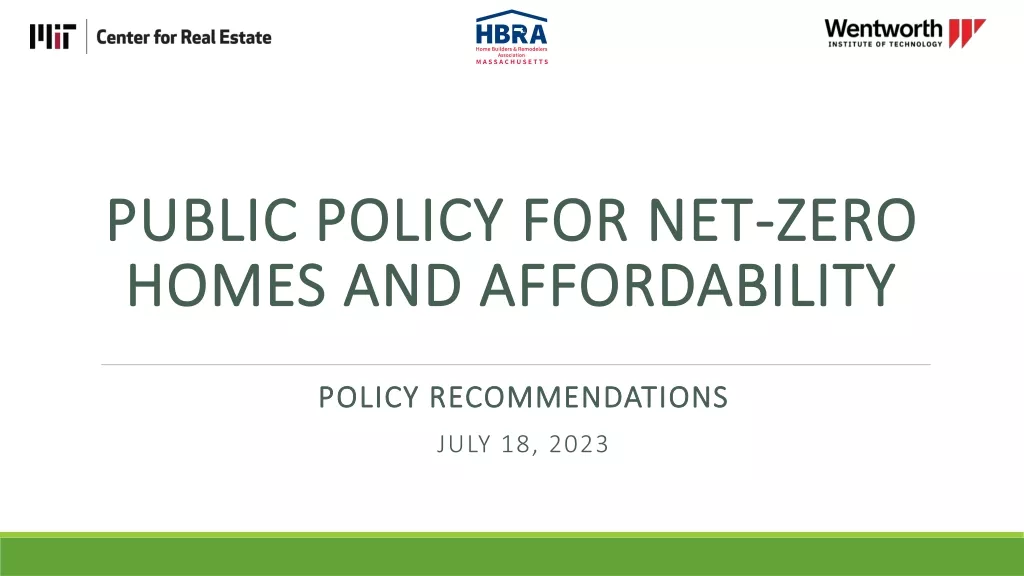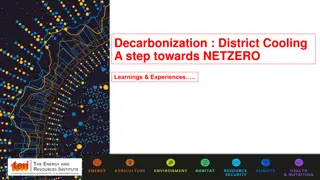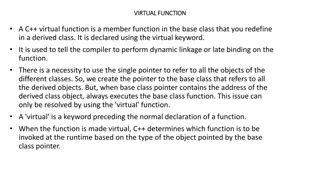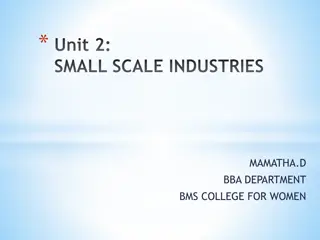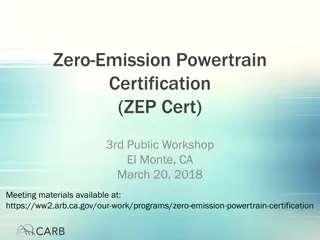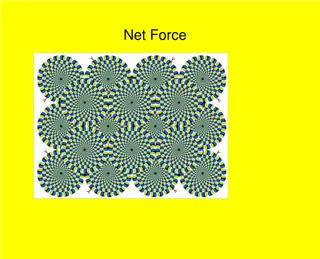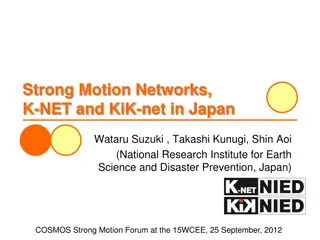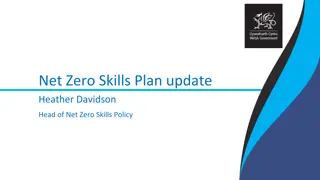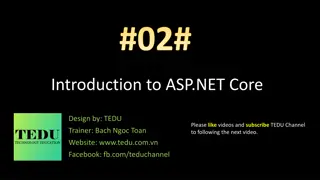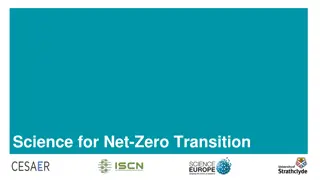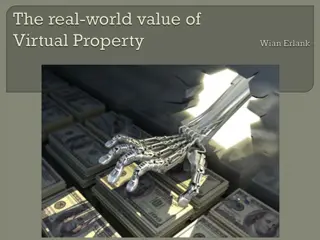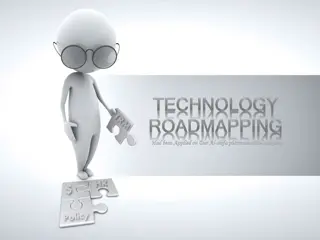TFI Network+ Virtual Workshop: Roadmapping to Net Zero for Foundation Industries
TFI Network+ recently conducted a virtual workshop focusing on roadmapping to achieve net zero in foundation industries. The workshop included presentations on energy-efficient processes, raw material utilization, and thermal sensors. Attendees discussed gaps, synergies, key technologies, and implementation barriers for energy efficiency across sectors. Check out the recorded sessions and pre-existing roadmaps for reference.
Uploaded on Oct 05, 2024 | 0 Views
Download Presentation

Please find below an Image/Link to download the presentation.
The content on the website is provided AS IS for your information and personal use only. It may not be sold, licensed, or shared on other websites without obtaining consent from the author. Download presentation by click this link. If you encounter any issues during the download, it is possible that the publisher has removed the file from their server.
E N D
Presentation Transcript
Roadmapping for the Foundation Industries Outcomes from Workshop
TFI Network+ held its first virtual workshop, bringing the foundation industries together to discuss roadmapping to net zero. The workshop included an overview of the recent UKRI report on innovation in the foundation industries as well as presentations on energy efficient processes, raw material utilisation and thermal and related sensors. A recording of the main stage sessions is now available for catch up here: https://www.youtube.com/watch?v=i20FbwFZGKg The Network has also compiled a list of pre-existing roadmaps for reference: https://tfinetworkplus.org/tfi-network-workshop-pre-existing-sector-roadmaps/
Event Speakers and Sessions Welcome and introduction by Ian Reaney Ben Walsh, Overview of Innovate UK Transforming Foundation Industries Challenge Temitope Akinremi, Innovation and strategy towards net-zero 2050 in the Foundation Industries Ian Reaney and Cameron Pleydell-Pearce, State of the art in energy efficient processes William Sampson and Susan Bernal-Lopez, State of the art in raw materials utilisation- technical challenges to enabling industrial symbiosis Jon Willmott, Thermal and related sensors in the Foundation Industries Plus three breakout sessions during the workshop
Audience Analysis Which area best describes your sector/interest? 11% 12% bulk chemicals 10% cement 20% ceramics glass metals 18% paper other 15% 14% Note: attendees were able to choose more than one interest area
Audience Analysis Academic/Industry/Other 23% academic 41% industry Other 36%
Session 1: this focussed on energy efficiency in the foundation industries. The questions for discussion during the breakout session were: 1. What gaps do you think there are in the roadmaps in your sectors and across sectors for energy efficiency? 1. What synergies do you think there are in the roadmaps in your sectors and across sectors for energy efficiency? 1. What are the key energy efficient technologies that the N+ should focus on? 1. What are the barriers to implementation?
Session 1. Themes emerging from the discussion A. Waste heat Delegates commented on the issue of waste heat and its reuse. This included practical issues such as: 1. the technical difficulty of recovering waste heat, e.g. low grade heat; 2. utilising radiative rather than conductive heat recovery; 3. the practicalities of heat storage. 4. Changing materials formulations to require lower processing temperatures 5. Is there an opportunity to store energy from renewables (wind, solar, etc) as heat in geo-assets onshore? Capex/business model related issues were also mentioned such as: 1. cost of retrofit for new technologies; 2. conflict with existing CHP contracts; 3. lack of a way to export heat to possible end users; 4. The need for more collaboration between Fis 5. The need to consider heat in various road maps B. Waste streams Comments on waste streams included: 1. A lack of available knowledge of what waste is available and how it can be processed into raw material, or used by downstream industries 2. Design materials to optimise for use/reuse across a range of manufacturing sectors and design for deconstruction 3. Regulations which may differ across authorities 4. Quality issues of recycled materials and that glass, metal, plastic are competitors for packaging materials 5. Increase the value of recycled components
Session 1. Themes emerging from the discussion C. Hydrogen and CCS/U 1. How will hydrogen or CCU/S be integrated, and how will it affect plants? What are the by-products and what issues might these cause? 2. In the UK there is motivation to create industrial clusters particularly to make the most of H2 and CCU 3. Hard to justify changing existing equipment-hydrogen important, but a lot of changes will be needed 4. Hydrogen is missing from roadmaps D. Alternative fuels or electricity sources 1. Technologies for net-zero not quite there, but not necessarily the most important. Furthermore, energy efficiency is not necessarily the same thing as low carbon. Also, where are the system boundaries and are we double counting emissions? 2. Note that industry alone doesn t have to be net zero by 2050, the whole economy does 3. Current fuel (electric) costs are prohibitive and future scale/costs of electrification are unknown 4. Is there an opportunity to shift to small onsite nuclear reactors for some industries, or further integrate renewable technologies? 5. Alternative fuels or energy sources need to be considered. e.g. more use of plasmas, alternative fuels for cement/binder sector, renewables and biofuel 6. The UK s biomass strategy needs to have better data in order to use the energy where it will have the most impact
Session 1. Themes emerging from the discussion E. Comments in the roadmaps 1. Mapping of cross sectoral opportunities to save energy appears to be missing generally 2. Rate of change of industries has outstripped the roadmaps which will need refinement and make wider changes 3. Roadmaps are missing (1) realistic fiscal interventions and (2) social impacts. For example, embodied emissions of EVs are often overlooked. Look at the whole system F. Communication and data, other 1. 2. Opportunities to use big data an digitalise process control for efficiency, improvements and to pool resources Refectories are heat treated on site and often handled by maintenance. Communication with the right people in companies to enable improvements Connecting mobile plants. Is the technology developed enough (5 years?) Financial drivers are needed- started to be offered Disruptive technologies Mini mill and EAF shows small plants can work 3. 4. 5. 6. 7.
Session 2: Resource Recovery in the Foundation Industries- Opportunities and Challenges to Enable Symbiosis The questions for discussion during the breakout session were: 1. What are the current practices/ strategies for management and/or valorisation of wastes in your industry? 1. What waste streams are ripe for valorisation? What do you do now that you won t be able to in 10, 20 years? 1. What are the main barriers for resource recovery from wastes in your industry? 1. What will be the main enablers (e.g. policy, standards, incentives) facilitating wider resource recovery from waste?
Session 2. Themes emerging from the discussion A. What are the current practices/strategies for management and/or waste valorisation of wastes in your industry? 1. Supply of some wastes becoming rarer, e.g. fly ash from coal power, but there are also growing problems with the International transport of waste, e.g. use of correct terminology 2. Only landfill materials should be called waste materials; should waste be relabelled as material ? 3. Characterisation and accreditation of materials through life cycle to allow waste to be wider used as raw materials 4. Would an Ebay of waste or a national materials datahub facilitate industrial symbiosis? Who would facilitate this? 5. Defunct patents exist to cover the identification of materials and maintenance of information for long term B. What are the main barriers for resource recovery from wastes in your industry? 1. End users require confidence of the quality and availability of the feedstock: 2. issues of variability/composition, toxicity and recertification 3. Suitable quantities, logistics, and storage 4. Stable pricing, and the availability of virgin materials at lower cost than recycled 5. Regulators have a lack of knowledge and understanding, and regulations prohibit the blending of potentially useful/valuable waste streams 6. Need to provide better quality data to end users and regulators 7. High level policy decisions are required 8. Incentives and responsibilities for who should manage the waste, e.g. those creating it? 9. Recycling can be a labour and energy intensive process, so how to minimise
Session 2. Themes emerging from the discussion C. What waste streams are ripe for valorisation? What do you do now that you won t be able to do in 10-20 years? 1. Waste sand, spent investment casting shell and high value refractories are being sent to landfill 2. Plastics, polymers, and carbon/glass reinforced fibres 3. Slag from other sources like aluminium or BOS plant 4. Opportunities to reuse filter dust, calumite, glass cullet, aggregates from demolition 5. One growth area will be air pollution control residues for the next 10-20 years until the new fleet of energy from waste plants starts to scale down 6. Dewatered effluent sludge has a high ash content that can be used use in cement industry 7. Process sludge from dust and steel- stockpiled, can t all be recycled, high zinc content- landfilled. Iron- value. Removal of zinc is an issue- technical process
Session 2. Themes emerging from the discussion D. What will be the main enablers facilitating wider resource recovery from waste? 1. Giving more responsibility for primary materials producers e.g. - - - - Carbon tax on primary materials will make secondary materials more competitive Greater extended and/or individual producer responsibility Making materials producers custodians for their materials and responsible for the products they produce Suppliers to provide open data on material they are selling 2. Regulatory issues such as - - A directory of by products with their quality certified Creating markets for secondary resources, which will likely require collaboration with the environmental regulators Legislation regarding landfill Environmental permits can be expensive. Waste regulations, constraints, increasing flexibility. Easier to recover waste materials Make use of by-product allowance permitted in existing standards Specification such as color needs to be corrected Recertification services - - - - -
Session 2. Themes emerging from the discussion D. What will be the main enablers facilitating wider resource recovery from waste? 3. Economic or business issues such as - - Cost benefit analysis of processing, and incentives to mitigate cost Design to deconstruct, and for manufacturers not to combine materials in ways that are irreversible (or energetically expensive) think plastic coated card How to identify useful waste materials for the market Building supply chains around carbon intensity? Marketplace for exchange and trading. Where to source these materials? Market design New business models and better communication/collaboration between industries - - - -
Session 3. Thermal and Related Sensors in the Foundational Industries The questions for discussion during the breakout session were: 1. What do you think could be the possible costs (financial and environmental) of not measuring, or improperly measuring, process variables like temperature in your field? 1. Have you seen any good practice applying instruments to measure in the foundation industries? 1. Do you think people will be open to creating opportunities to share and learn ideas for good measurements between foundation industries? 1. Do you have any ideas for new measurements that are needed in the foundation industries where off-the-shelf solutions aren t currently available?
Session 3. Themes emerging from the discussion A. What do you think could be the possible costs of not measuring, or improperly measuring, process variables like temperature in your field? 1. Higher than necessary energy use, costs and CO2, along with poorer product quality 2. Increased wear on equipment and plant that will create greater volume of wastes that cannot be reused, more frequently B. Have you seen any good practice applying instruments to measure in the FIs? 1. Making testing routine and monitor business critical aspects of production-quality, cost, safety 2. Electromagnetic measurement of material properties at high temperatures (below curie) for steel manufacture which is tied to process models 3. Acoustic temperature sensing by KIma process has a nice fast response vs thermocouples and gives gas temp (not affected by radiation) C. Do you have any ideas for new measurements that are needed in the FIs where off the shelf solutions aren t currently available? 1. I would love to know the temperature inside a powder bed in a rotary kiln indeed the whole temp profile 2. Accurate liquid steel temperature measurement techniques 3. Air leak detection (into and out of) our processes could be better 4. Develop Sankey diagrams to identify areas of interest and material flow 5. In large ladles of metal, the heat will not be consistent across materials. What can be gained by improving accuracy?
Session 3. Themes emerging from the discussion Some common issues identified include: Communication and sharing of across industries: Data needs to be the same specification to be usable. Use standard to ensure this. Not well understood currently. Product made to specification so information should be collected in the same way. Need process for using data, from collection to analysis to implementation Data should be traceable through design and process (also applied to materials recovery and reuse) Disparity in monitoring across FIs. Some know overall energy, some know granular details and could identify hot spots . Need to understand how powerful this data can be. Difficult to engage FIs to share knowledge More likely between different sectors- not competing Ability to learn from one another- external threat more worrying than competition between companies Potentially more happy these days- depends on industry Instrument technology vendors working closely with companies to produce joined up thinking to process monitoring systems IP- linked to control systems 10. Good practice often obscured between different companies by NDAs etc 11. Know-how from each sector of softwares and procedures for simulations/optimisation processes not willing to share 12. FIs have traditionally not worked together on technical issues, this is something that needs to be overcome. The community aspect of the N+ needs to find a way to overcome this 1. 2. 3. 4. 5. 6. 7. 8. 9.
Session 3. Themes emerging from the discussion Skills & training 1. Instrumentation is not visible and/or easily obtained by SMEs due to lack of confidence, understanding and expertise. Older industries will need these technologies and skills to be retrofitted 2. Lots of options for measurement so understanding of what instrumentation system can deliver 3. Gauge existing standards but always look to progress them. Need good practice 4. Need case studies to show benefits of measurement and how it can save money etc AI and big data were mentioned regularly as part of the discussion: 1. Some manufacturing processes are heavily instrumented and produce large amounts of data that could take very long (or is difficult) to interpret, can AI or machine learning be used to solve this? 2. The steel industry is starting to consider the use of AI in steel making to make steel more accurately 3. There is an opportunity to showcase what AI can do, however input must be standard for AI to use it (GIGO) and must take into account human interaction with the collected data 4. Variation in use of automation, data across different businesses 5. Governance of data- AI real-time data to change behaviour 6. Automation- resolution of instrumentation General comment 1. Steel: check temperature measurements with handheld devices to understand degradation of equipment etc, by understanding hotspots 2. Trends and changes in temperature monitoring, digitisation important. Stability 3. Temp profiles 4. Fine margins, Profit from volume 5. Middleman to facilitate. Innovation broker
Conclusion - Attendees agreed mappings of cross-sectional opportunities were generally missing in pre-existing roadmaps, missing opportunities in wider industrial manufacturing - Business models were important factors in process change including communication channels as well as time and resources to develop partnerships or trial methods - Barriers were identified in adapting new technology including lack of regulator knowledge, limited time and opportunity for training and insufficient data for end users - Attendees agreed roadmaps and policy had sparked discussion in their sectors, creating an openness to collaborate and trial new ideas - Following the workshop, the Network launched their first funding call on the theme 'energy efficient manufacturing'. Further information on scope and eligibility are available on TFI Network+ website.
Thank you to all our workshop attendees
